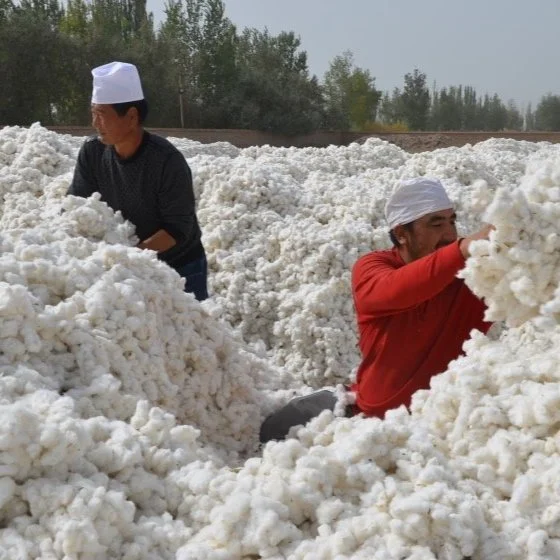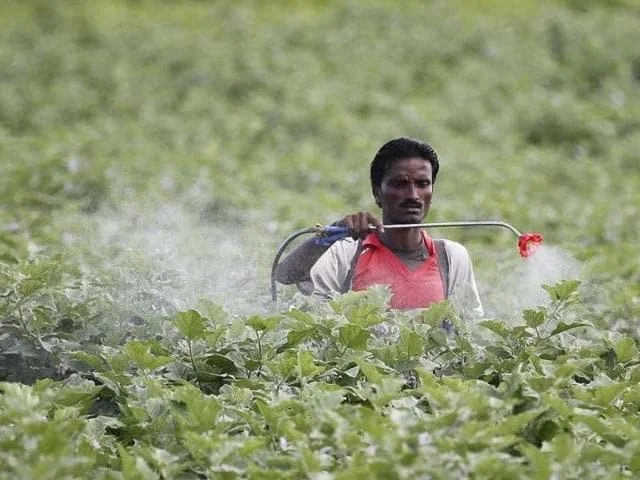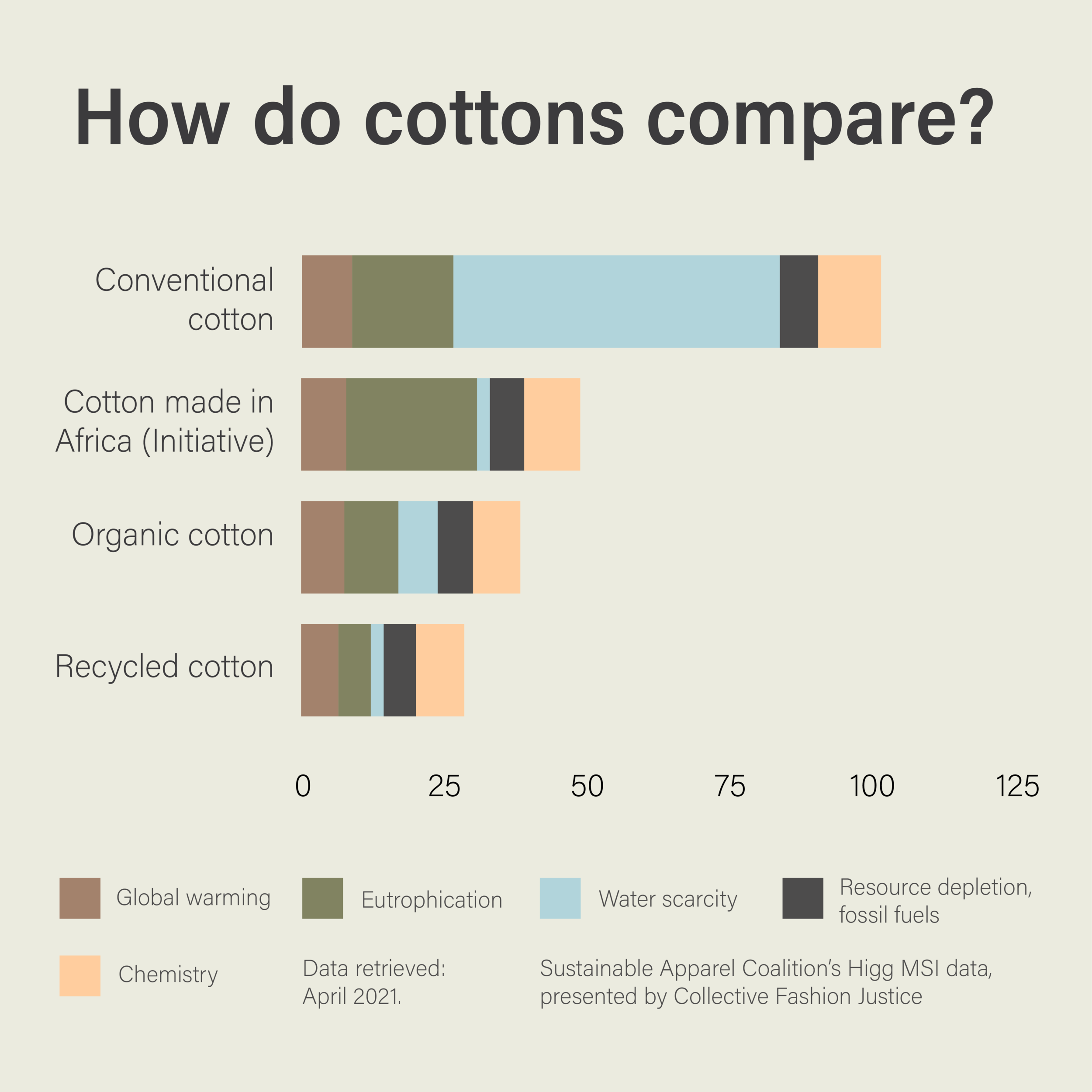Issues in conventional cotton supply chains
Far too much of the world’s cotton is produced with exploitative labour and while causing environmental harm.
Cotton is a fantastic material, made from a soft flowering plant which requires little processing in order to be wearable.
But it must be sourced right.
Cotton is easily recycled, it is derived from a plant rather than an animal, and it can compost very quickly, unlike synthetic materials. However, these very positive attributes must be paired with an equally positive supply chain.
Not all cotton is produced on farms which use sustainable agricultural practices, and a lot of cotton available on the market today is produced in supply chains which violate human rights. It doesn’t need to be this way, and by being aware of these issues, we can help to create change.
How can cotton production harm the planet?
-

Excessive water use
While a large number of publications have over-estimated the water footprint of the average cotton crop, many cotton supply chains still use water excessively. Water scarcity is an important issue for the fashion industry to address and act on.
Historically, intense cotton irrigation which did not consider the planet has been use, and still is today by many producers. However, lots of farmers are changing: Australian cotton farmers, for example, have reduced their water use by 48% since 1992.Too, a large portion of cotton produced today, particularly in India and Africa, is entirely rain-fed, requiring no additional water use.
-

Soil degradation
The practice of ‘tilling’ or turning over soil to prepare it for crop planting is used across the world. Today, we have learned that lower tillage rates benefit soil health.
Unfortunately, many cotton producers still till the land to a high degree, resulting in a loss of organic matter, a decreased presence of beneficial microorganisms and nutrients, and less carbon storage capability.Fortunately, sustainable agricultural practices popularised through the rise of permaculture are used by many other cotton farmers. Rotational cropping, for example, helps soil remain nutrient rich.
-

Harmful pesticide use
Cotton crops account for 4.7% of global pesticide sales, and 10.24% of insecticide sales. While some insecticides are not persistent or harmful to the environment – for example, Bt is a biological soil bacterium sprayed over certified organic cotton crops – many are.
Harmful pesticides can cause major biodiversity destruction through soil and water contamination. Insects are critical to ecosystem health, and also to sustainable farming.
Some cotton plant genetic modification has allowed for major insecticide use reductions – for example in Australia, by 97% since 1993. The use of ‘refuge crops’ also reduce chemical use, however the global industry must continue to improve.

As many as 1 in 5 cotton garments sold around the world can be tied back to the Xinjiang province of China, where the government is accused of forcing Uyghur Muslims into labour.
Forced labour and child labour continue to exist in many global cotton supply chains
The vast majority of cotton produced around the world is grown across China, India, the United States, Pakistan, Brazil, Australia, Uzbekistan and Turkey. Across many of these countries, issues of unjust, exploitative and forced labour persist.
The vast majority of fashion brands are not able to trace their raw materials back to the farms they come from, meaning they cannot confirm that child and forced labour is not occurring.
Fairtrade certifications, legislative change to protect vulnerable communities, and transparent supply chains built on a dedication to ensuring ethical treatment for everyone are all important factors in transforming the cotton and broader fashion industry’s supply chains.
Harmful pesticide usage and its impact on farmers and surrounding communities
Lower income communities often do not have the same access to safety gear when using pesticides on cotton plants. As a result, they face severe health risks. These communities are sometimes less able to access more effective plant protection strategies and tools, meaning they rely on out-dated and more harmful substances.
Severe poisoning of farmers, the poisoning of children whose homes are near sprayed cotton fields and the contamination of waterways used for drinking are all serious problems. These issues similarly harm free-living wild animals.
Image: a farmer spraying pesticides onto a cotton field in India. Poorer countries continue to use pesticides, including those which are likely carcinogens, even when they are banned in other countries. (Raj K Raj / HT)
The type of cotton that is used to produce garments makes a significant difference to the sustainability and ethics of those garments.
Certified organic cotton, recycled cotton, rain-fed cotton, and cotton produced in different countries and with different practices all have varying footprints – varying even more than the data to the left can express.
For example, even within Australia, some cotton producers have stolen water, while others only use rain water. Traceable Australian cotton like Good Earth Cotton is more sustainable than many other crops, too.
Transparency, improved legislation and certifications (like GOTS) are all important to ensure we are making good choices.
Want to learn more about cotton and more ethical, sustainable knitwear?
Our multi-award winning short film, Willow and Claude, follows our founding director Emma Hakansson as she learns why it’s best to avoid both wool and synthetics, and creates a total ethics knitwear supply chain, using sustainably sourced Australian cotton.
See the full Willow and Claude website here, or watch the film below.
Want to keep learning?
-

Is cotton more sustainable than wool?
When it comes to knitwear, cotton can be used as an alternative to both animal and synthetic fibres. Cotton is not as cruel as wool, but which is more sustainable?
-

Wool
Like cotton, wool is biodegradable and considered natural. However, this does not mean that it is sustainable, nor does it nullify the cruelty to animals involved in producing it.
-

Deforestation and biodiversity loss
When it comes to material sustainability, land and biodiversity impacts are critical to consider. Cotton is a fairly land-efficient crop, how do other materials fare?





